Engineering Business Environment docx
VerifiedAdded on 2022/09/16
|7
|1651
|27
AI Summary
Contribute Materials
Your contribution can guide someone’s learning journey. Share your
documents today.
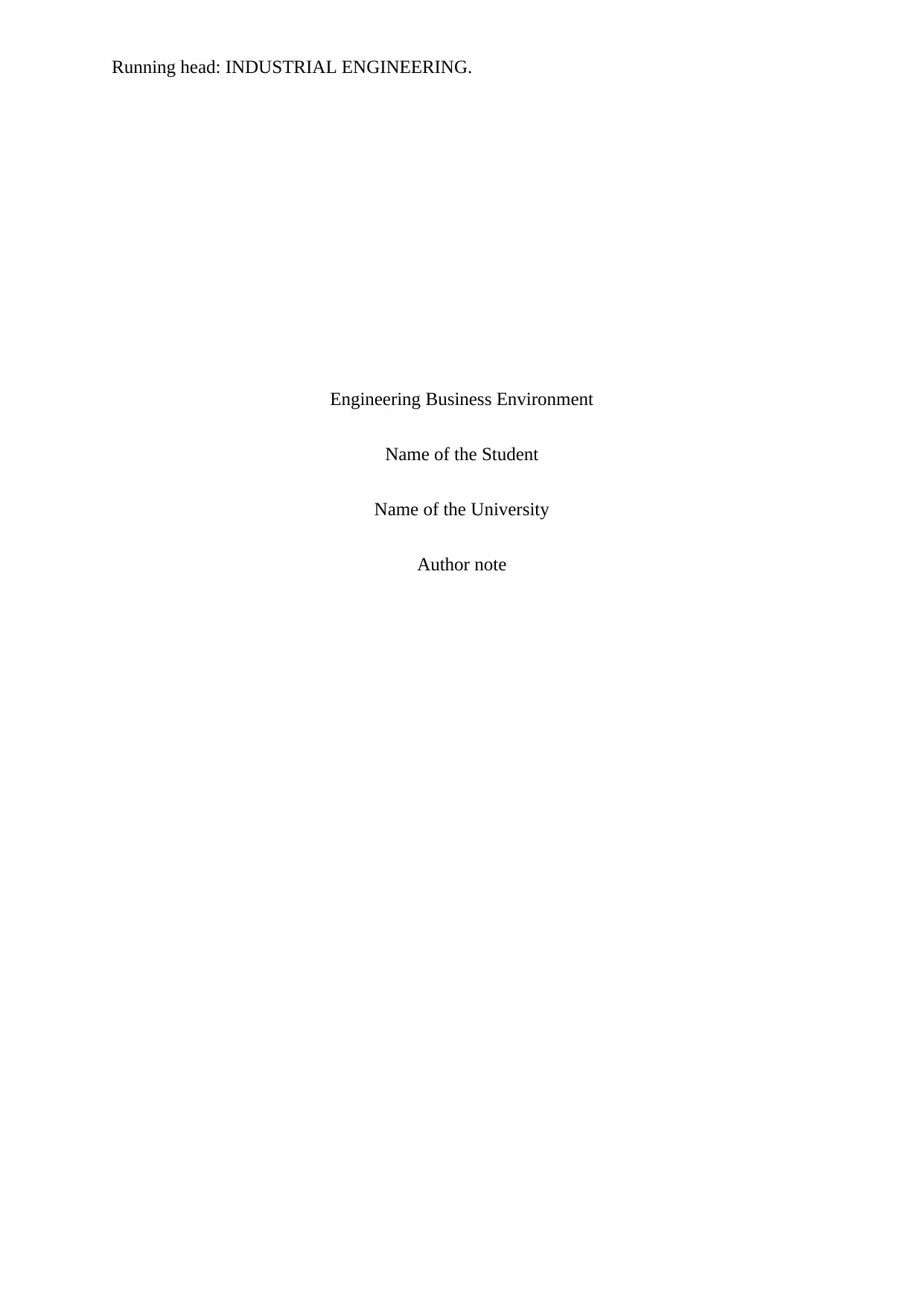
Running head: INDUSTRIAL ENGINEERING.
Engineering Business Environment
Name of the Student
Name of the University
Author note
Engineering Business Environment
Name of the Student
Name of the University
Author note
Secure Best Marks with AI Grader
Need help grading? Try our AI Grader for instant feedback on your assignments.
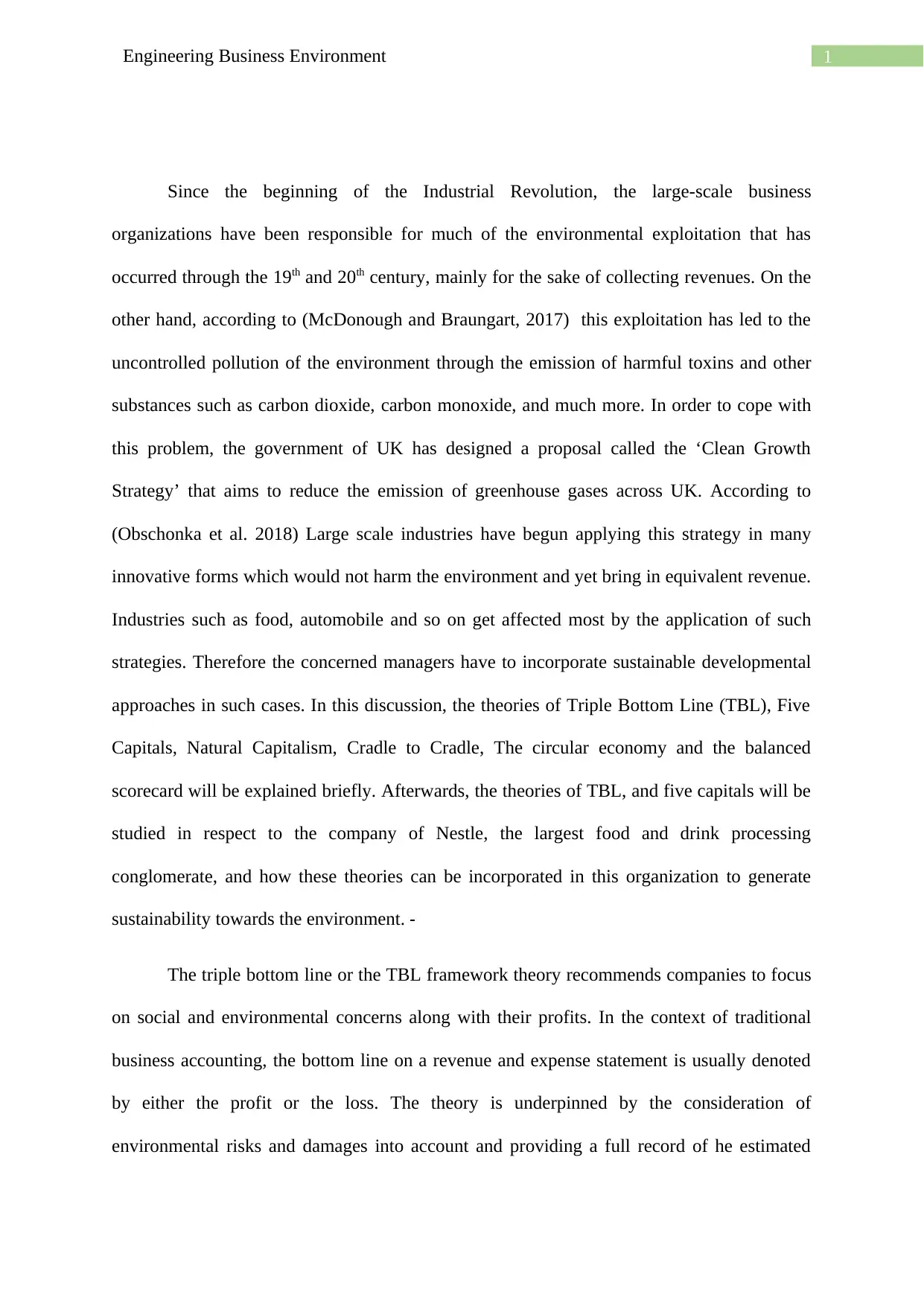
1Engineering Business Environment
Since the beginning of the Industrial Revolution, the large-scale business
organizations have been responsible for much of the environmental exploitation that has
occurred through the 19th and 20th century, mainly for the sake of collecting revenues. On the
other hand, according to (McDonough and Braungart, 2017) this exploitation has led to the
uncontrolled pollution of the environment through the emission of harmful toxins and other
substances such as carbon dioxide, carbon monoxide, and much more. In order to cope with
this problem, the government of UK has designed a proposal called the ‘Clean Growth
Strategy’ that aims to reduce the emission of greenhouse gases across UK. According to
(Obschonka et al. 2018) Large scale industries have begun applying this strategy in many
innovative forms which would not harm the environment and yet bring in equivalent revenue.
Industries such as food, automobile and so on get affected most by the application of such
strategies. Therefore the concerned managers have to incorporate sustainable developmental
approaches in such cases. In this discussion, the theories of Triple Bottom Line (TBL), Five
Capitals, Natural Capitalism, Cradle to Cradle, The circular economy and the balanced
scorecard will be explained briefly. Afterwards, the theories of TBL, and five capitals will be
studied in respect to the company of Nestle, the largest food and drink processing
conglomerate, and how these theories can be incorporated in this organization to generate
sustainability towards the environment.
The triple bottom line or the TBL framework theory recommends companies to focus
on social and environmental concerns along with their profits. In the context of traditional
business accounting, the bottom line on a revenue and expense statement is usually denoted
by either the profit or the loss. The theory is underpinned by the consideration of
environmental risks and damages into account and providing a full record of he estimated
Since the beginning of the Industrial Revolution, the large-scale business
organizations have been responsible for much of the environmental exploitation that has
occurred through the 19th and 20th century, mainly for the sake of collecting revenues. On the
other hand, according to (McDonough and Braungart, 2017) this exploitation has led to the
uncontrolled pollution of the environment through the emission of harmful toxins and other
substances such as carbon dioxide, carbon monoxide, and much more. In order to cope with
this problem, the government of UK has designed a proposal called the ‘Clean Growth
Strategy’ that aims to reduce the emission of greenhouse gases across UK. According to
(Obschonka et al. 2018) Large scale industries have begun applying this strategy in many
innovative forms which would not harm the environment and yet bring in equivalent revenue.
Industries such as food, automobile and so on get affected most by the application of such
strategies. Therefore the concerned managers have to incorporate sustainable developmental
approaches in such cases. In this discussion, the theories of Triple Bottom Line (TBL), Five
Capitals, Natural Capitalism, Cradle to Cradle, The circular economy and the balanced
scorecard will be explained briefly. Afterwards, the theories of TBL, and five capitals will be
studied in respect to the company of Nestle, the largest food and drink processing
conglomerate, and how these theories can be incorporated in this organization to generate
sustainability towards the environment.
The triple bottom line or the TBL framework theory recommends companies to focus
on social and environmental concerns along with their profits. In the context of traditional
business accounting, the bottom line on a revenue and expense statement is usually denoted
by either the profit or the loss. The theory is underpinned by the consideration of
environmental risks and damages into account and providing a full record of he estimated
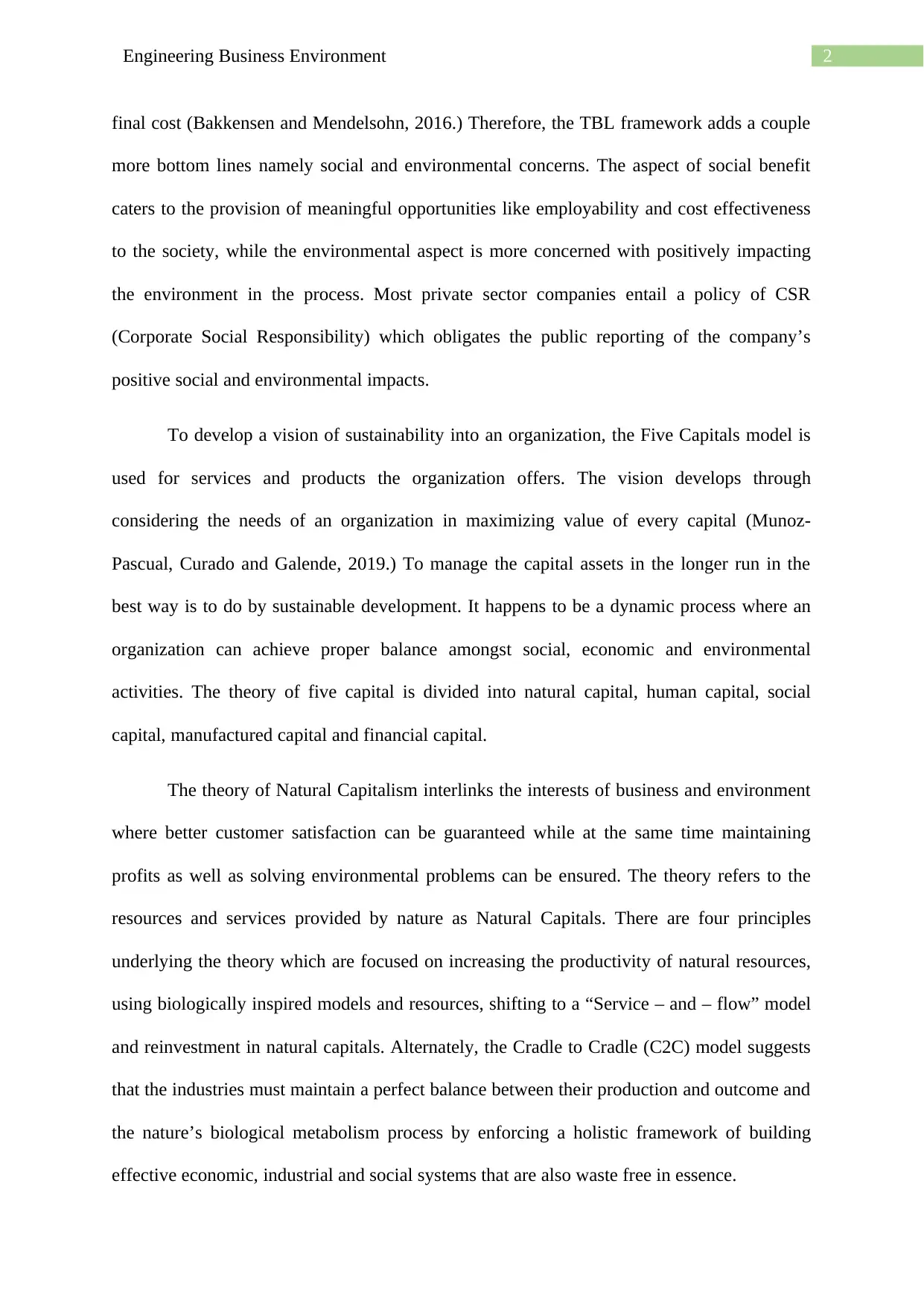
2Engineering Business Environment
final cost (Bakkensen and Mendelsohn, 2016.) Therefore, the TBL framework adds a couple
more bottom lines namely social and environmental concerns. The aspect of social benefit
caters to the provision of meaningful opportunities like employability and cost effectiveness
to the society, while the environmental aspect is more concerned with positively impacting
the environment in the process. Most private sector companies entail a policy of CSR
(Corporate Social Responsibility) which obligates the public reporting of the company’s
positive social and environmental impacts.
To develop a vision of sustainability into an organization, the Five Capitals model is
used for services and products the organization offers. The vision develops through
considering the needs of an organization in maximizing value of every capital (Munoz-
Pascual, Curado and Galende, 2019.) To manage the capital assets in the longer run in the
best way is to do by sustainable development. It happens to be a dynamic process where an
organization can achieve proper balance amongst social, economic and environmental
activities. The theory of five capital is divided into natural capital, human capital, social
capital, manufactured capital and financial capital.
The theory of Natural Capitalism interlinks the interests of business and environment
where better customer satisfaction can be guaranteed while at the same time maintaining
profits as well as solving environmental problems can be ensured. The theory refers to the
resources and services provided by nature as Natural Capitals. There are four principles
underlying the theory which are focused on increasing the productivity of natural resources,
using biologically inspired models and resources, shifting to a “Service – and – flow” model
and reinvestment in natural capitals. Alternately, the Cradle to Cradle (C2C) model suggests
that the industries must maintain a perfect balance between their production and outcome and
the nature’s biological metabolism process by enforcing a holistic framework of building
effective economic, industrial and social systems that are also waste free in essence.
final cost (Bakkensen and Mendelsohn, 2016.) Therefore, the TBL framework adds a couple
more bottom lines namely social and environmental concerns. The aspect of social benefit
caters to the provision of meaningful opportunities like employability and cost effectiveness
to the society, while the environmental aspect is more concerned with positively impacting
the environment in the process. Most private sector companies entail a policy of CSR
(Corporate Social Responsibility) which obligates the public reporting of the company’s
positive social and environmental impacts.
To develop a vision of sustainability into an organization, the Five Capitals model is
used for services and products the organization offers. The vision develops through
considering the needs of an organization in maximizing value of every capital (Munoz-
Pascual, Curado and Galende, 2019.) To manage the capital assets in the longer run in the
best way is to do by sustainable development. It happens to be a dynamic process where an
organization can achieve proper balance amongst social, economic and environmental
activities. The theory of five capital is divided into natural capital, human capital, social
capital, manufactured capital and financial capital.
The theory of Natural Capitalism interlinks the interests of business and environment
where better customer satisfaction can be guaranteed while at the same time maintaining
profits as well as solving environmental problems can be ensured. The theory refers to the
resources and services provided by nature as Natural Capitals. There are four principles
underlying the theory which are focused on increasing the productivity of natural resources,
using biologically inspired models and resources, shifting to a “Service – and – flow” model
and reinvestment in natural capitals. Alternately, the Cradle to Cradle (C2C) model suggests
that the industries must maintain a perfect balance between their production and outcome and
the nature’s biological metabolism process by enforcing a holistic framework of building
effective economic, industrial and social systems that are also waste free in essence.
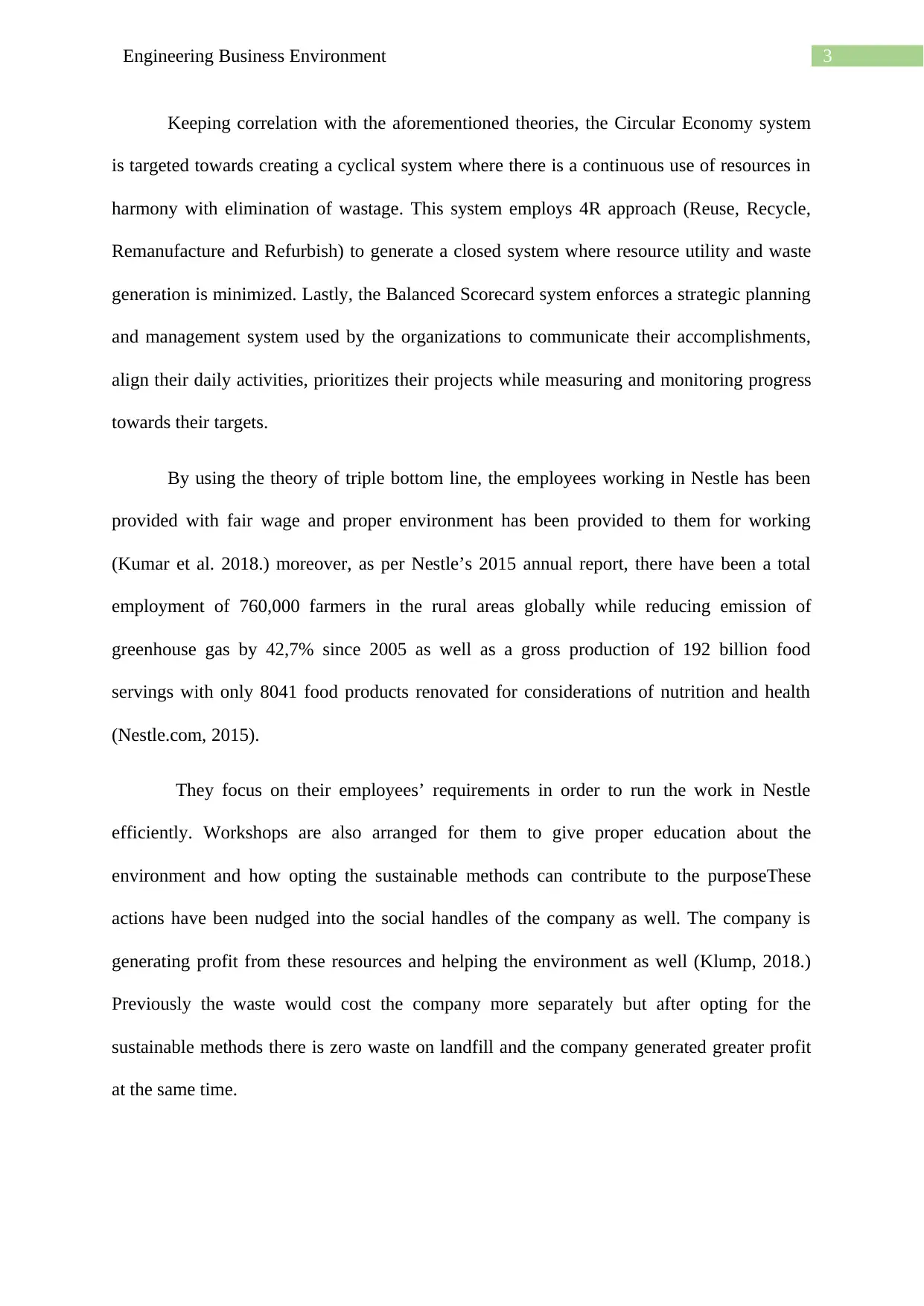
3Engineering Business Environment
Keeping correlation with the aforementioned theories, the Circular Economy system
is targeted towards creating a cyclical system where there is a continuous use of resources in
harmony with elimination of wastage. This system employs 4R approach (Reuse, Recycle,
Remanufacture and Refurbish) to generate a closed system where resource utility and waste
generation is minimized. Lastly, the Balanced Scorecard system enforces a strategic planning
and management system used by the organizations to communicate their accomplishments,
align their daily activities, prioritizes their projects while measuring and monitoring progress
towards their targets.
By using the theory of triple bottom line, the employees working in Nestle has been
provided with fair wage and proper environment has been provided to them for working
(Kumar et al. 2018.) moreover, as per Nestle’s 2015 annual report, there have been a total
employment of 760,000 farmers in the rural areas globally while reducing emission of
greenhouse gas by 42,7% since 2005 as well as a gross production of 192 billion food
servings with only 8041 food products renovated for considerations of nutrition and health
(Nestle.com, 2015).
They focus on their employees’ requirements in order to run the work in Nestle
efficiently. Workshops are also arranged for them to give proper education about the
environment and how opting the sustainable methods can contribute to the purposeThese
actions have been nudged into the social handles of the company as well. The company is
generating profit from these resources and helping the environment as well (Klump, 2018.)
Previously the waste would cost the company more separately but after opting for the
sustainable methods there is zero waste on landfill and the company generated greater profit
at the same time.
Keeping correlation with the aforementioned theories, the Circular Economy system
is targeted towards creating a cyclical system where there is a continuous use of resources in
harmony with elimination of wastage. This system employs 4R approach (Reuse, Recycle,
Remanufacture and Refurbish) to generate a closed system where resource utility and waste
generation is minimized. Lastly, the Balanced Scorecard system enforces a strategic planning
and management system used by the organizations to communicate their accomplishments,
align their daily activities, prioritizes their projects while measuring and monitoring progress
towards their targets.
By using the theory of triple bottom line, the employees working in Nestle has been
provided with fair wage and proper environment has been provided to them for working
(Kumar et al. 2018.) moreover, as per Nestle’s 2015 annual report, there have been a total
employment of 760,000 farmers in the rural areas globally while reducing emission of
greenhouse gas by 42,7% since 2005 as well as a gross production of 192 billion food
servings with only 8041 food products renovated for considerations of nutrition and health
(Nestle.com, 2015).
They focus on their employees’ requirements in order to run the work in Nestle
efficiently. Workshops are also arranged for them to give proper education about the
environment and how opting the sustainable methods can contribute to the purposeThese
actions have been nudged into the social handles of the company as well. The company is
generating profit from these resources and helping the environment as well (Klump, 2018.)
Previously the waste would cost the company more separately but after opting for the
sustainable methods there is zero waste on landfill and the company generated greater profit
at the same time.
Secure Best Marks with AI Grader
Need help grading? Try our AI Grader for instant feedback on your assignments.
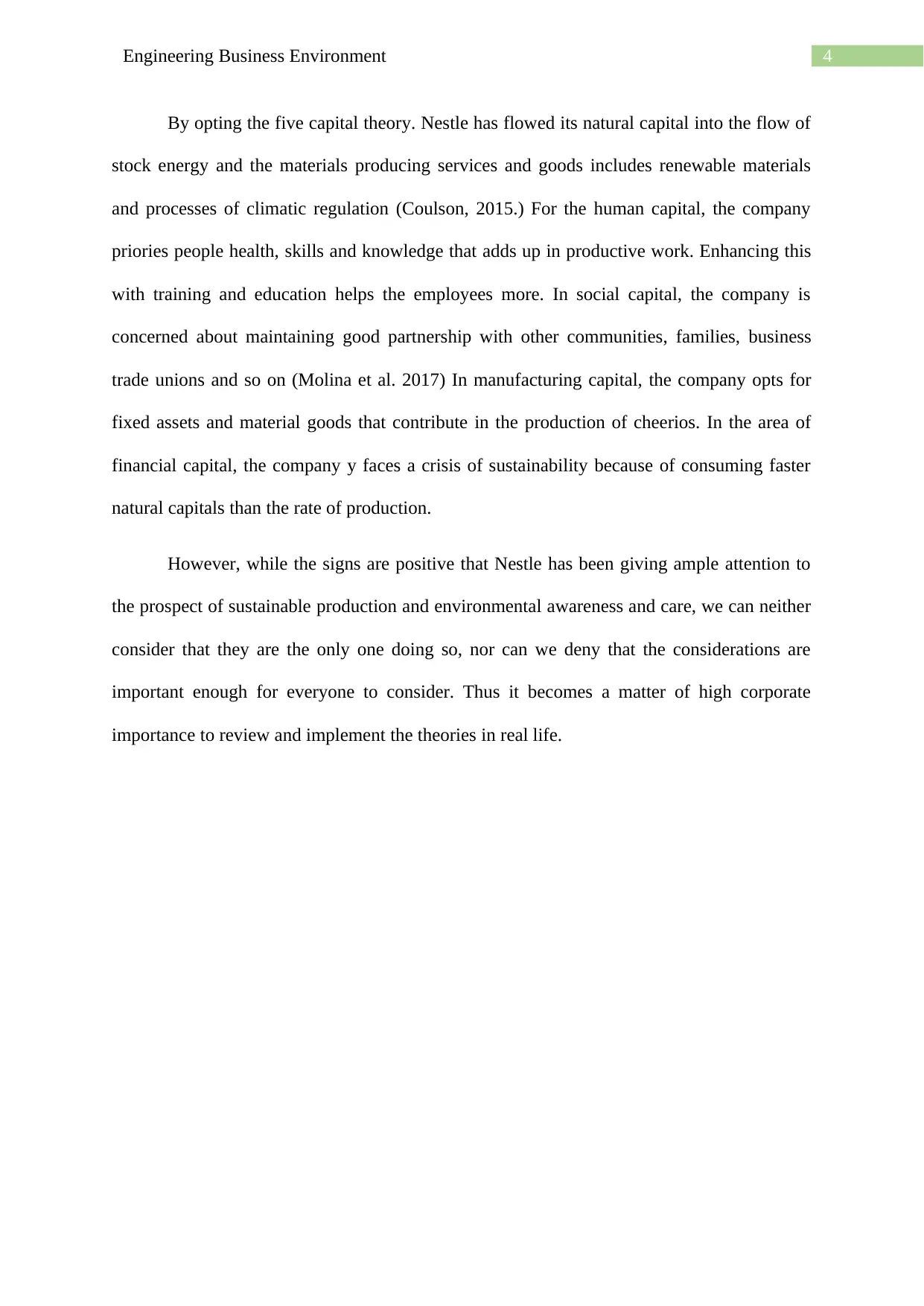
4Engineering Business Environment
By opting the five capital theory. Nestle has flowed its natural capital into the flow of
stock energy and the materials producing services and goods includes renewable materials
and processes of climatic regulation (Coulson, 2015.) For the human capital, the company
priories people health, skills and knowledge that adds up in productive work. Enhancing this
with training and education helps the employees more. In social capital, the company is
concerned about maintaining good partnership with other communities, families, business
trade unions and so on (Molina et al. 2017) In manufacturing capital, the company opts for
fixed assets and material goods that contribute in the production of cheerios. In the area of
financial capital, the company y faces a crisis of sustainability because of consuming faster
natural capitals than the rate of production.
However, while the signs are positive that Nestle has been giving ample attention to
the prospect of sustainable production and environmental awareness and care, we can neither
consider that they are the only one doing so, nor can we deny that the considerations are
important enough for everyone to consider. Thus it becomes a matter of high corporate
importance to review and implement the theories in real life.
By opting the five capital theory. Nestle has flowed its natural capital into the flow of
stock energy and the materials producing services and goods includes renewable materials
and processes of climatic regulation (Coulson, 2015.) For the human capital, the company
priories people health, skills and knowledge that adds up in productive work. Enhancing this
with training and education helps the employees more. In social capital, the company is
concerned about maintaining good partnership with other communities, families, business
trade unions and so on (Molina et al. 2017) In manufacturing capital, the company opts for
fixed assets and material goods that contribute in the production of cheerios. In the area of
financial capital, the company y faces a crisis of sustainability because of consuming faster
natural capitals than the rate of production.
However, while the signs are positive that Nestle has been giving ample attention to
the prospect of sustainable production and environmental awareness and care, we can neither
consider that they are the only one doing so, nor can we deny that the considerations are
important enough for everyone to consider. Thus it becomes a matter of high corporate
importance to review and implement the theories in real life.
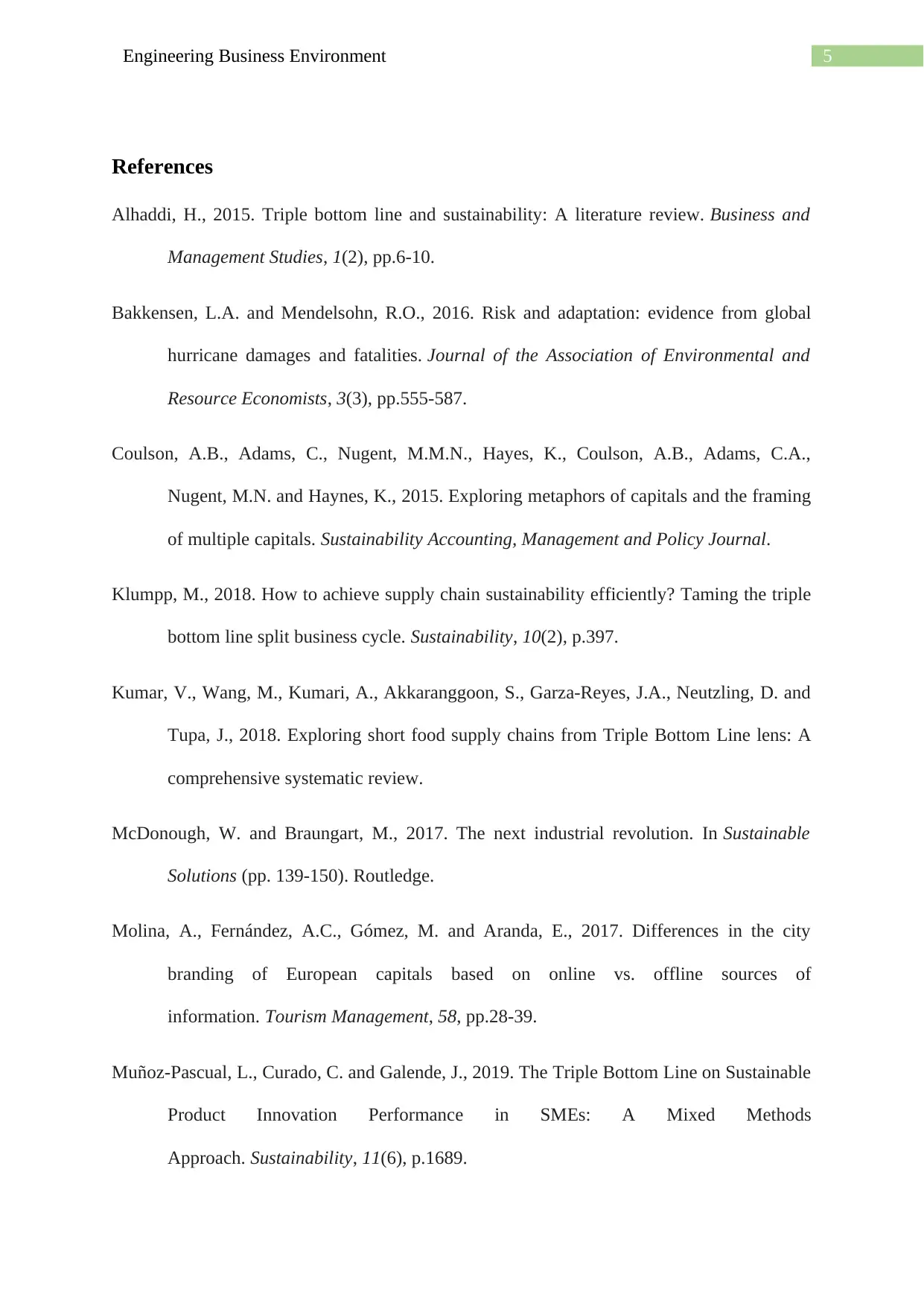
5Engineering Business Environment
References
Alhaddi, H., 2015. Triple bottom line and sustainability: A literature review. Business and
Management Studies, 1(2), pp.6-10.
Bakkensen, L.A. and Mendelsohn, R.O., 2016. Risk and adaptation: evidence from global
hurricane damages and fatalities. Journal of the Association of Environmental and
Resource Economists, 3(3), pp.555-587.
Coulson, A.B., Adams, C., Nugent, M.M.N., Hayes, K., Coulson, A.B., Adams, C.A.,
Nugent, M.N. and Haynes, K., 2015. Exploring metaphors of capitals and the framing
of multiple capitals. Sustainability Accounting, Management and Policy Journal.
Klumpp, M., 2018. How to achieve supply chain sustainability efficiently? Taming the triple
bottom line split business cycle. Sustainability, 10(2), p.397.
Kumar, V., Wang, M., Kumari, A., Akkaranggoon, S., Garza-Reyes, J.A., Neutzling, D. and
Tupa, J., 2018. Exploring short food supply chains from Triple Bottom Line lens: A
comprehensive systematic review.
McDonough, W. and Braungart, M., 2017. The next industrial revolution. In Sustainable
Solutions (pp. 139-150). Routledge.
Molina, A., Fernández, A.C., Gómez, M. and Aranda, E., 2017. Differences in the city
branding of European capitals based on online vs. offline sources of
information. Tourism Management, 58, pp.28-39.
Muñoz-Pascual, L., Curado, C. and Galende, J., 2019. The Triple Bottom Line on Sustainable
Product Innovation Performance in SMEs: A Mixed Methods
Approach. Sustainability, 11(6), p.1689.
References
Alhaddi, H., 2015. Triple bottom line and sustainability: A literature review. Business and
Management Studies, 1(2), pp.6-10.
Bakkensen, L.A. and Mendelsohn, R.O., 2016. Risk and adaptation: evidence from global
hurricane damages and fatalities. Journal of the Association of Environmental and
Resource Economists, 3(3), pp.555-587.
Coulson, A.B., Adams, C., Nugent, M.M.N., Hayes, K., Coulson, A.B., Adams, C.A.,
Nugent, M.N. and Haynes, K., 2015. Exploring metaphors of capitals and the framing
of multiple capitals. Sustainability Accounting, Management and Policy Journal.
Klumpp, M., 2018. How to achieve supply chain sustainability efficiently? Taming the triple
bottom line split business cycle. Sustainability, 10(2), p.397.
Kumar, V., Wang, M., Kumari, A., Akkaranggoon, S., Garza-Reyes, J.A., Neutzling, D. and
Tupa, J., 2018. Exploring short food supply chains from Triple Bottom Line lens: A
comprehensive systematic review.
McDonough, W. and Braungart, M., 2017. The next industrial revolution. In Sustainable
Solutions (pp. 139-150). Routledge.
Molina, A., Fernández, A.C., Gómez, M. and Aranda, E., 2017. Differences in the city
branding of European capitals based on online vs. offline sources of
information. Tourism Management, 58, pp.28-39.
Muñoz-Pascual, L., Curado, C. and Galende, J., 2019. The Triple Bottom Line on Sustainable
Product Innovation Performance in SMEs: A Mixed Methods
Approach. Sustainability, 11(6), p.1689.
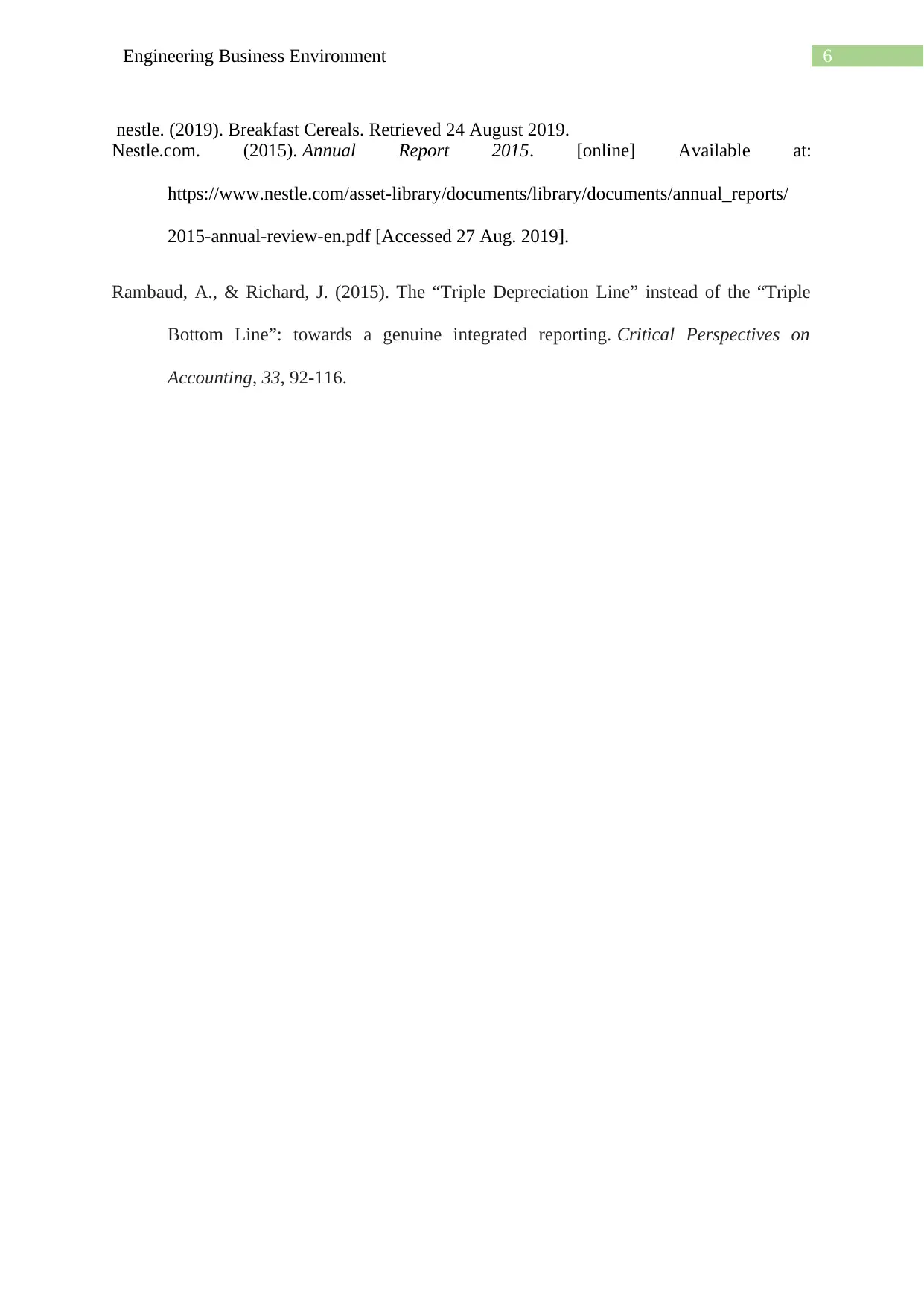
6Engineering Business Environment
nestle. (2019). Breakfast Cereals. Retrieved 24 August 2019.
Nestle.com. (2015). Annual Report 2015. [online] Available at:
https://www.nestle.com/asset-library/documents/library/documents/annual_reports/
2015-annual-review-en.pdf [Accessed 27 Aug. 2019].
Rambaud, A., & Richard, J. (2015). The “Triple Depreciation Line” instead of the “Triple
Bottom Line”: towards a genuine integrated reporting. Critical Perspectives on
Accounting, 33, 92-116.
nestle. (2019). Breakfast Cereals. Retrieved 24 August 2019.
Nestle.com. (2015). Annual Report 2015. [online] Available at:
https://www.nestle.com/asset-library/documents/library/documents/annual_reports/
2015-annual-review-en.pdf [Accessed 27 Aug. 2019].
Rambaud, A., & Richard, J. (2015). The “Triple Depreciation Line” instead of the “Triple
Bottom Line”: towards a genuine integrated reporting. Critical Perspectives on
Accounting, 33, 92-116.
1 out of 7
Related Documents
Your All-in-One AI-Powered Toolkit for Academic Success.
+13062052269
info@desklib.com
Available 24*7 on WhatsApp / Email
![[object Object]](/_next/static/media/star-bottom.7253800d.svg)
Unlock your academic potential
© 2024 | Zucol Services PVT LTD | All rights reserved.




